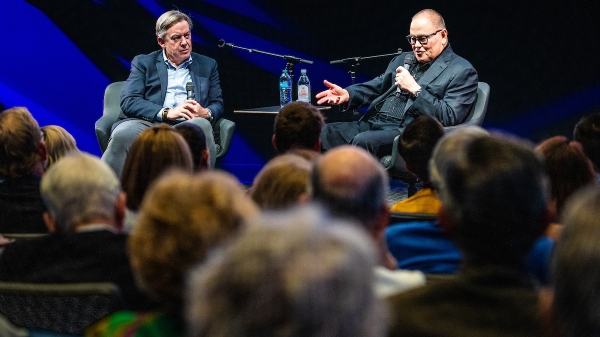Editor's note: This story originally appeared in the winter 2022 issue of ASU Thrive magazine.
Written by May Busch, former COO of Morgan Stanley Europe, executive coach, speaker, adviser, author and executive-in-residence in ASU’s Office of the President.
When you’re feeling anxious, lost or worried about your career, then step back, zoom out and get your bearings by looking at your entire career visually. This also works as a way to plan out a successful career that moves you toward your aspirations.
Here’s how I look at this: I call it the "S-Curve," and it’s a graph of your career potential over time. It’s also the shape of a learning curve, which is another way to think of your career — as a series of learning opportunities.
Where are you now?
Let’s think of your career in three primary stages:
- “Aspiring” — the early stage.
- “Driving” — the middle stage.
- “Arriving” — the advanced stage.
Aspiring
When you’re in the aspiring stage, you’re starting out and exploring career options. You’re working hard, developing skills and gaining a variety of experiences. But your visible achievement is still quite modest because you’re building a foundation.
It’s like those construction sites that are fenced off with dark green hoarding. You walk by on the way to work for months and it doesn’t look like any progress is being made. But what they’re doing is extremely important — they’re digging the foundation.
Driving
Then comes the driving stage, when you’ve chosen where you want to make your mark and must demonstrate all the things that it takes to be excellent in your chosen field. In my case, it was how to run a deal, lead a team, build client relationships and become a “rainmaker” who brings in business.
In the construction analogy, this is when all of a sudden, the building structure seems to go up in a very short period of time. Similarly, your visible achievement tends to be much greater during the driving stage.
Arriving
When you’ve achieved your desired level of success, this is what I call the arriving stage. You’re still working hard but you’ve achieved so much that the incremental achievement no longer seems as big. This is because expectations of you have risen along with your capabilities — your own expectations as well as the expectations of others.
Back to the hypothetical building, this is working on the interior and putting in all the pipes, wiring and walls. There’s a tremendous amount of important work going on, but it doesn’t look like much is happening from the outside.
The question mark
At some point during this arriving stage, you may find yourself thinking, “What’s next? Is this all there is?” And indeed, there is a question mark at the end of the arriving stage.
That’s when you have some choices to make. Do you opt out and retire altogether, keep doing what you’ve been doing and coast a bit, or decide to get on a new S-Curve, whether that’s re-upping your commitment to advance where you are or doing something completely different?
Which S-Curve are you on?
The good news is that none of us is limited to just one S-Curve in our careers. In fact, your overall career S-Curve is made up of smaller S-Curves that link up. While each distinct segment of your career constitutes a different S-Curve, you don’t have to start all the way at the bottom when you jump onto a new S-Curve. That’s because you’ve developed skills, capabilities, experience and wisdom along the way that you can build upon.
For example, my first career S-Curve was my 24-year investment banking career. I then got to the question mark and chose to get on a new S-Curve and become an entrepreneur who helps achievers accelerate their career success. In my second S-Curve, I’m just starting the driving stage.
Putting it all together
No matter where you are, it’s important to recognize what stage you’re in, the aspirations you have and how you can keep learning, growing and staying engaged in the work you do.
Because when you’re engaged and using your best talents, you become unstoppable in your career.
More Business and entrepreneurship

3 ways to start sounding like an executive
Story by May BuschEditor's note: This story was featured in the winter 2025 issue of ASU Thrive.Whether you love meetings or hate them, they are golden opportunities to demonstrate your executive…

How individuals and businesses can rethink their resolutions this year
Making resolutions is common this time of year.Losing weight. Leading a healthier lifestyle. Breaking a bad habit or two. These are all pledges millions of Americans make at the start of a new year.…

Scrappy, adaptive, inventive: A fireside chat with GoDaddy’s Bob Parsons
GoDaddy founder, Vietnam War Marine veteran and New York Times bestselling author Bob Parsons joined Arizona State University President Michael Crow for a fireside chat at ASU’s MIX Center in Mesa on…
